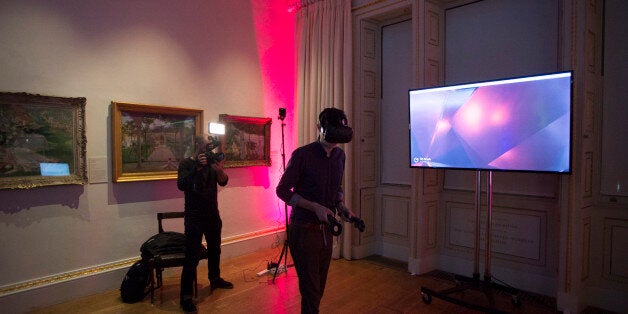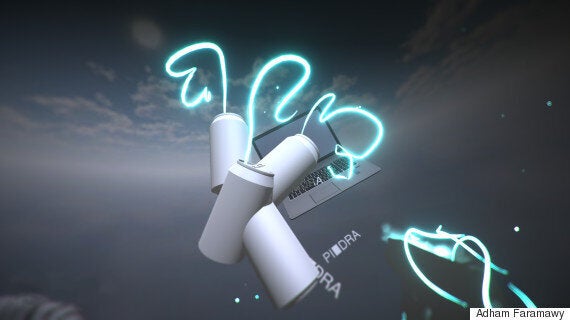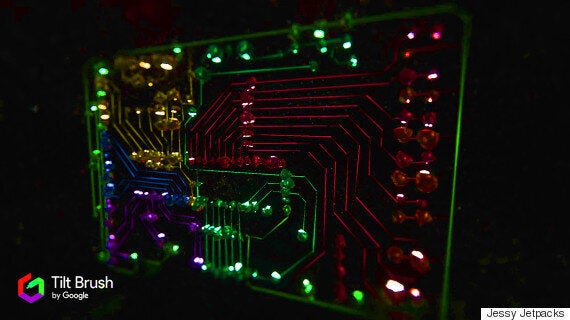
Is it possible to turn the virtual into reality? This is the theme we drew on for the Virtually Real project which will open to the public at the Royal Academy on 12th January.
Faramawy, a Royal Academy Schools alumni and Jetpacks, a current student reveal our experiences creating the world's first 3D printed artwork, made in virtual reality:
Adham Faramawy
I was invited recently to make some work using a new virtual reality headset called HTC Vive and to extract a physical sculpture from what I produce in virtual reality.
I'm an artist and I often work with technology but this was unusual in that there are new applications that allow you to draw and sculpt in the VR environment. Up until now I would have designed objects, architectures and environments on a desktop PC, and imported them into the software to be perceived on the headset. But this is new, something a bit more intuitive. I was energised by the idea that you can make drawings and sculpture digitally and see them coming together in three dimensions, in real time around your body. When you watch someone else using the headset, it can look like dancing, really clumsy dancing, but a little romantic nonetheless.

My work is about bodies. I love charting the sensual, feeling the weight, the smell, and the taste of something. Mainly, I'm interested in how things feel to the touch. I always wonder when I use a new technology: how does this affect how I think about my body and what does it do for the person I'm trying to communicate with? What does it mean to represent something, or to translate an idea from one material into another?
You are disembodied in the Vive experience. You can see your hand held controllers, but you have no body. You're a floating eyeball. This got me thinking about the conventions that mark out space, describing what it's for. In art galleries it's the white walls and grey floor. They tell you where you are but they're invisible. In a way there's no need for those markers in VR. There's no real need to replicate space. It's not easy to assign physics to objects in the virtual environment, and why do we really need them?
I was never a gamer but this was always my problem with Second Life. So many people wanted to replicate something that already exists, when actually these technologies can be quite useful speculative tools. Even though the way platforms are designed guides how you use them, they can still be used to visualise a variety of possibilities. And what's wrong with imagining new ways to be situated in the world?

In fact, where tech fails to replicate physics could be an opportunity for experimentation. Let's play with gravity. Why have walls? Let's scale objects up and down and create spaces that are experimental and can't exist physically. Why design plinths for sculptures? They don't need support in virtual reality anyway. They float.
Jessy Jetpacks
When I first experienced virtual reality, I was immediately filled with the techno optimism that has been fuelling virtual reality's development since at least the late 60s. It's hard not to get excited about the possible applications, although I'm wary of the utopic platitudes that sometimes accompany tech developments. I don't think art needs virtual reality, or tech revitalisation. Art uses the materials and languages of its time, place, and societal contexts.
That said, as an (sometimes maximalist) artist who makes audio, video, and digital sculpture, virtual reality is a dream 'new material', and I feel incredibly lucky to be working with it in its relative infancy. I'm interested in its ability to defy normal physics, play with scale, and the potential for interactivity.

To create a submersive dream world of my imagining. I'm working with my excitement at the novelty, because a common issue with new materials is that certain nuances -- for example; humour, whimsy, or, implications of banality -- become harder to achieve. As virtual reality becomes more mainstream, the ways it can be used in art will change. It will be interesting when VR is inevitably used to subvert itself. Artists (like myself) are typically drawn to both the successes and failings of technologies.
The ever pervasive interest in the glitch, I think, is related to needing to expose false promises of consumerism, and to undermine or repossess agency from the seduction of technology. Videos of virtual reality art programs appear performative and intuitive: you wave your arms around and art can come out. I don't tend to work like that even when I paint and draw. I like to consider options, and improvise work arounds. I like units and combining elements, whether they are tones of humour, audio clips, words, images etc. I began making replicated units, using basic shapes in the modelling program, combining them through placement.
This led to sculpting segmented objects, then to animating them. Were I unbound by skill, time and resource constraints, I would probably build some kind of interactive multiple-timeline game/environment. Currently, I am making a walking simulator, which produces an interesting relationship with the sculptural element. It's been hard to consider how sculpture lives, outside of the VR experience. It can be exciting in and of itself, but like a celebrity, its body is now supercharged with the recent memory of its activation and presence 'in-screen'.

Who knows at this point if the sculpture will live up to its memory, or live in its own world? I don't consider the sculpture to be capable of making the virtual reality real, nor the virtual reality capable of simulating a sculpture. Far more interesting is where those absences lie. Where the things are not, is where they become something else entirely.
The first ever 3D printed artwork created in virtual reality (VR) will go on display to the public from 12th - 14th January 2017 (Friends of the RA Preview 11thJanuary 2017), as part of an exclusive project between HTC Vive and The Royal Academy of Arts.
Tickets and further information can be found online at: